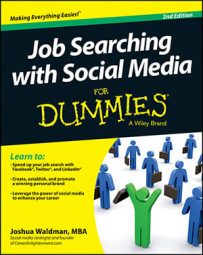Typically, the hardest step in getting started with Twitter is figuring out what on earth to say. Job seekers learning to use Twitter frequently say that their biggest fear is not knowing where all that content is going to come from. Don’t worry. If you can carry on a conversation, you can tweet. Here are some ways to find content easily:
Follow industry blogs: Compile a list of industry-relevant blogs to read weekly. Most blogs have a Tweet This feature that allows you to share the article directly via your Twitter account. Find industry blogs by checking out Alltop or Technorati.
If you can’t find enough industry-specific blogs in Alltop or Technorati, try entering this search string into Google:
“blogs + [industry name]”
Monitor news sites: One of Twitter’s greatest strengths is how fast it can spread news. Participate in spreading breaking news by monitoring news sites. When you tweet about an article, add a quick opinion to the message, like “Great article” or “I wonder why this is.”
Retweet good posts: When you retweet what your fellow tweeps have to say, you pay them the highest compliment. So find a few companies you want to follow and spend a few days reading their tweets. Then help them spread their message by retweeting them.
Posting links to articles and retweeting are great ways to get started, but you’ll want to get more personal after a while. After all, one of the main points of tweeting is to give employers a chance to get to know you better. The following list gives you an idea of the kinds of personal details and experiences that may be worth sharing:
A quote: Quotes are some of the most treasured tweets out there. Start collecting short quips to share on Twitter. If you hear a great one-liner in a movie or read something profound in a book, tweet it. Make sure you use the hashtag #quote to let your followers know you’re being pithy.
A question: After you have more followers, consider asking them questions. Questioning your network is a great way to build relationships.
Something special you do: If you do something special or unusual, share it. Ask yourself, “Does sharing this allow someone else a chance to feel closer to me?”
Something you see: If you see a killer sunset, snap a photo and share it with your followers. They may appreciate it, too. Use apps like Pheed or Instagram on your phone to do this easily.
An insight: If you have an opinion, a pet peeve, or a flash of insight about a topic, why not let your followers know? Initiate conversations around industry-relevant topics that you feel you can contribute to in an intelligent way. Or perhaps just wax philosophical.
A recommendation: Did you meet someone remarkable who helped you? Share your experience on Twitter and help promote your benefactor. Did you hire a résumé writer who rocked? Maybe you went to a networking group that was particularly worthwhile. All these topics make great recommendations to your network.
A direct communication: If you find someone you want to talk to, why not start a conversation? Use @[username] in your tweet to alert the other person. As long as your post doesn’t look like spam, chances are you’ll get a reply.
An interruption: Go to Twitter.com/i/discover to find a discussion that’s happening right now and interrupt it. Butt in. Give your two cents’ worth. Every Thursday, human-resource professionals have a Twitter chat. They use a special hashtag and welcome input from anyone listening in. Find a hashtag discussion about your industry to join. Read this article for a list of 50 of the hottest job seeker hashtags.
With any of these tweet ideas, try to incorporate the word you rather than I, me, or my. For example, say something like “You’ll love this new photo of the sunset from my weekend at Mt. Hood” or “What do you think of this new article on CNN?” You is a more retweeted word than I.
Ultimately, make sure your tweets are interesting and in line with your personal brand, and use your keywords occasionally. As long as you’re engaging and contributing to the collective conversation, you’re fine! Also remember to tweet other people the same way you want to be tweeted. Avoid coming across as obnoxious or banal.

